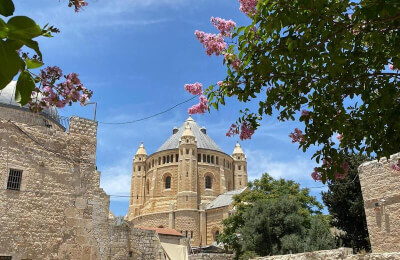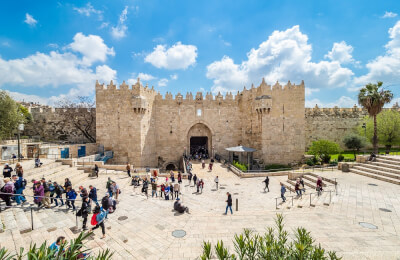Mystical Jerusalem. Friday the 13th Promotion
We also found excursions from other cities that are close to your departure city
Other excursions that also deserve your attention
# Kidron Valley: A Spiritual and Historical Ravine
The Kidron Valley, a profound and storied ravine, winds its way through the heart of Jerusalem, carrying with it a tapestry of history, spirituality, and legend. This valley, often overshadowed by the grandeur of Jerusalem's other iconic sites, holds its own unique allure, offering visitors a glimpse into the deep-rooted history of the city and its significance in various religious traditions. In this exploration of the Kidron Valley, we will delve into its rich history, uncover its spiritual importance, and share intriguing facts that make it a site worth discovering for those seeking to unravel the layers of Jerusalem's past.
## A Passage Through Time
### **Geographical Significance**
The Kidron Valley, known as the "Wadi Nar" in Arabic, is a narrow, elongated ravine that stretches from the eastern side of Jerusalem, near the Old City's Lions' Gate, to the southeast, leading to the Judean Desert. It serves as a natural drainage route for rainwater, carving its way through the landscape.
### **Historical Context**
Throughout the centuries, the Kidron Valley has played a vital role in the history of Jerusalem. Its location, connecting the city to the surrounding wilderness, has made it a significant passageway for travelers, conquerors, and armies. It has also served as a burial ground for countless generations, housing the tombs of biblical figures and kings.
## Spiritual Significance
### **In Judaism**
The Kidron Valley holds profound religious and spiritual importance in Judaism. It is associated with the Valley of Jehoshaphat, a biblical location mentioned in the Book of Joel and the Book of Revelation. According to Jewish tradition, it is believed that the final judgment will take place here, and the dead will be resurrected from their graves in the Kidron Valley.
### **In Christianity**
For Christians, the Kidron Valley holds significance as the route Jesus took during his final entry into Jerusalem, known as the "Palm Sunday Procession." According to the New Testament, Jesus and his disciples crossed the valley from the Mount of Olives on the way to Jerusalem, fulfilling the prophecy of Zechariah.
### **In Islam**
In Islam, the Kidron Valley is known as the "Valley of Guidance." It is mentioned in Islamic tradition as a place of resurrection and judgment. According to Islamic belief, the Angel of Death waits at the gates of Jerusalem, and when the time comes, souls pass through the Kidron Valley to the Day of Judgment.
## Sites of Interest
### **Absalom's Pillar**
One of the most prominent and recognizable structures in the Kidron Valley is Absalom's Pillar. This monumental tomb, often referred to as the Tomb of Absalom, is an ancient Jewish monument carved into the rock. Despite its name, it is unlikely to be the actual tomb of Absalom, the rebellious son of King David, but rather a memorial from a later period.
### **Zachariah's Tomb**
Located within the Kidron Valley is the Tomb of Zachariah, which is venerated by Jews, Christians, and Muslims. It is believed to be the final resting place of Zachariah, a biblical prophet. The tomb's architecture is a testament to the shared heritage of the Abrahamic faiths.
### **The Garden of Gethsemane**
The Kidron Valley is adjacent to the Garden of Gethsemane, an important Christian pilgrimage site. It is believed to be the place where Jesus prayed with his disciples on the night before his crucifixion. Ancient olive trees in the garden are thought to be among the oldest in the world.
### **The Monastery of St. Onuphrius**
Tucked away in the Kidron Valley is the Monastery of St. Onuphrius, a Christian Orthodox monastery named after the Egyptian monk Onuphrius. It is a serene and spiritual place, with a cave chapel and a stunning view of the valley.
## Intriguing Facts About the Kidron Valley
1. **Ancient Burial Ground:** The Kidron Valley has served as a burial ground for over 3,000 years. Tombs and burial chambers from various historical periods can be found along its slopes.
2. **Olive Trees of Gethsemane:** Some of the ancient olive trees in the Garden of Gethsemane are estimated to be around 2,000 years old, potentially dating back to the time of Jesus.
3. **UNESCO World Heritage Site:** The Old City of Jerusalem, which includes the Kidron Valley, is designated as a UNESCO World Heritage Site, recognized for its cultural and historical significance.
4. **Hidden Caves:** The Kidron Valley is home to several hidden caves, some of which have been used for spiritual retreats by hermits and monks throughout history.
5. **Kedron Brook:** In the rainy season, the Kidron Valley can become a rushing stream, historically referred to as the Kedron Brook. It has served as a natural defense barrier for Jerusalem.
## Planning Your Visit
For travelers planning to explore the Kidron Valley, here are some tips to enhance your experience:
1. **Proper Attire:** When visiting religious and historical sites in the valley, dress modestly and respectfully. This is especially important when entering religious structures and cemeteries.
2. **Guided Tours:** Consider joining a guided tour to gain deeper insights into the history, spirituality, and significance
of the Kidron Valley. Knowledgeable guides can provide valuable context.
3. **Sun Protection:** Depending on the season, the valley can be quite sunny and warm. Be sure to wear sunscreen, a hat, and comfortable walking shoes.
4. **Respectful Behavior:** Maintain a quiet and respectful demeanor when visiting religious sites and cemeteries, as these locations hold deep spiritual significance.
5. **Exploration:** Take the time to explore the various tombs and monuments along the valley's slopes. Each has its own unique history and architectural features.
## In Conclusion
The Kidron Valley, with its timeless beauty and profound spiritual significance, is a testament to the enduring power of faith and history. It is a place where the past converges with the present, where ancient tombs and monuments silently bear witness to the passage of time.
As you stand on the hallowed ground of the Kidron Valley, surrounded by the echoes of centuries, you are reminded of the shared heritage that connects the world's major religions and the deep reverence for this sacred place. It is a destination that invites reflection, contemplation, and a sense of awe—a place where the spiritual and historical converge in a timeless embrace.











